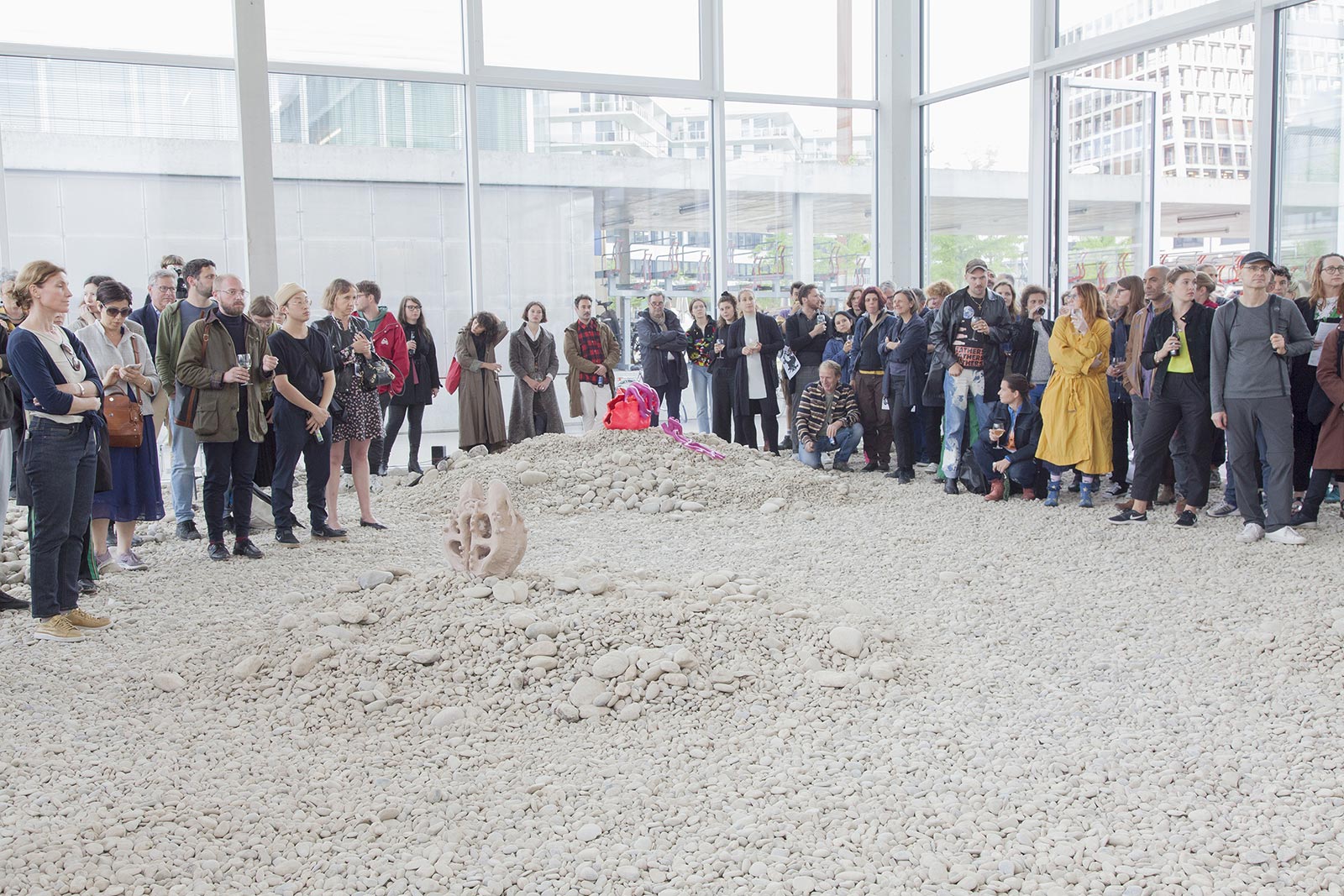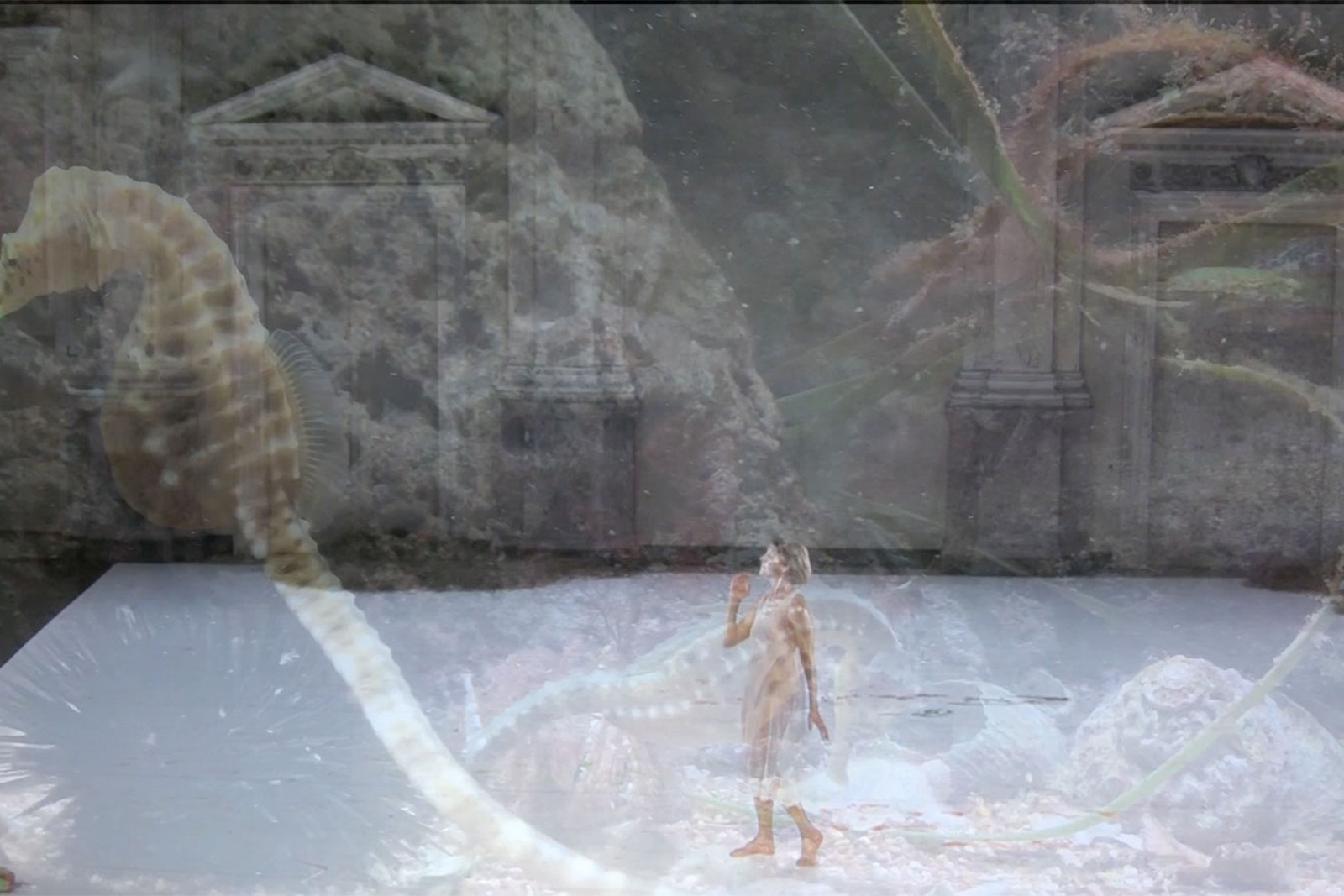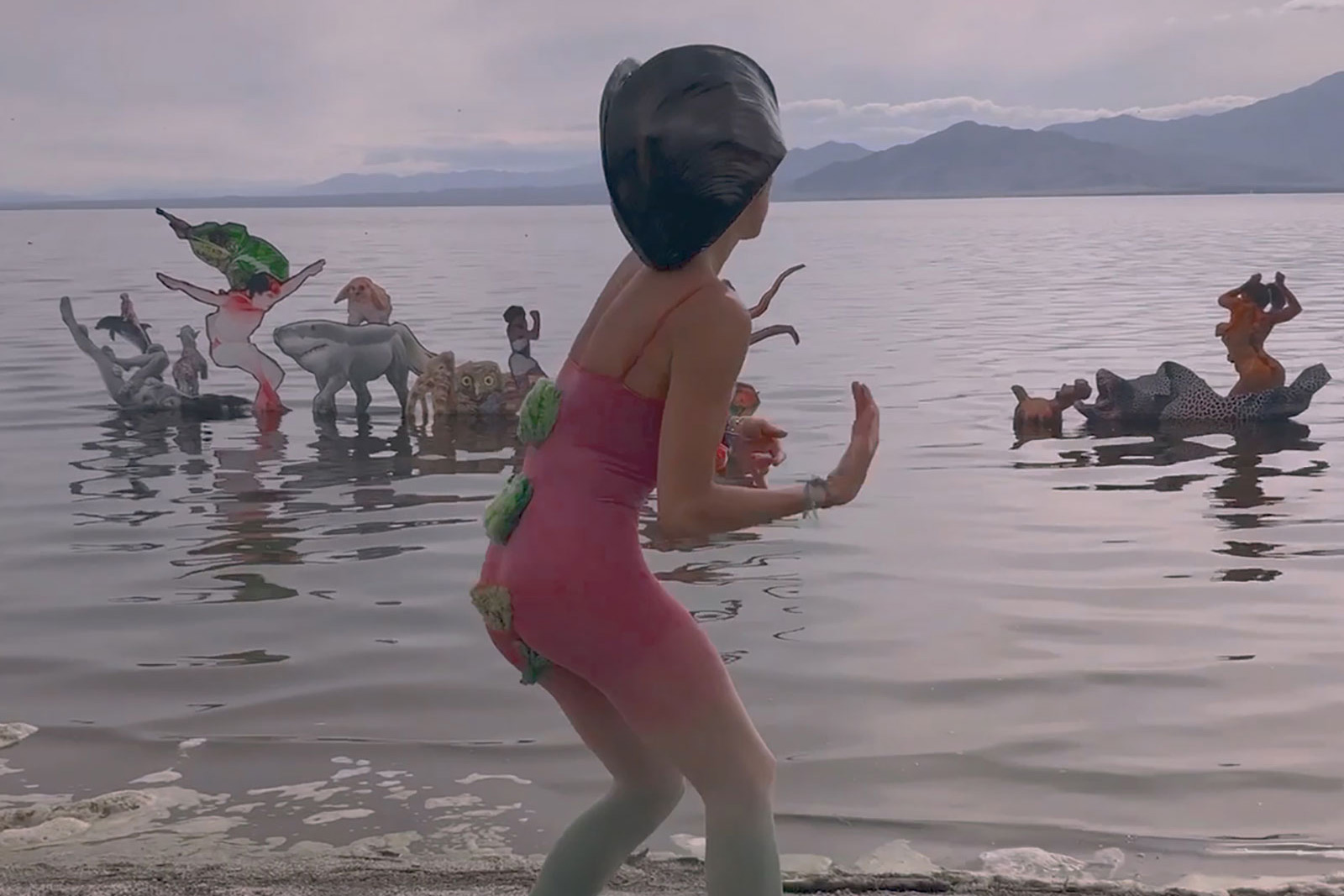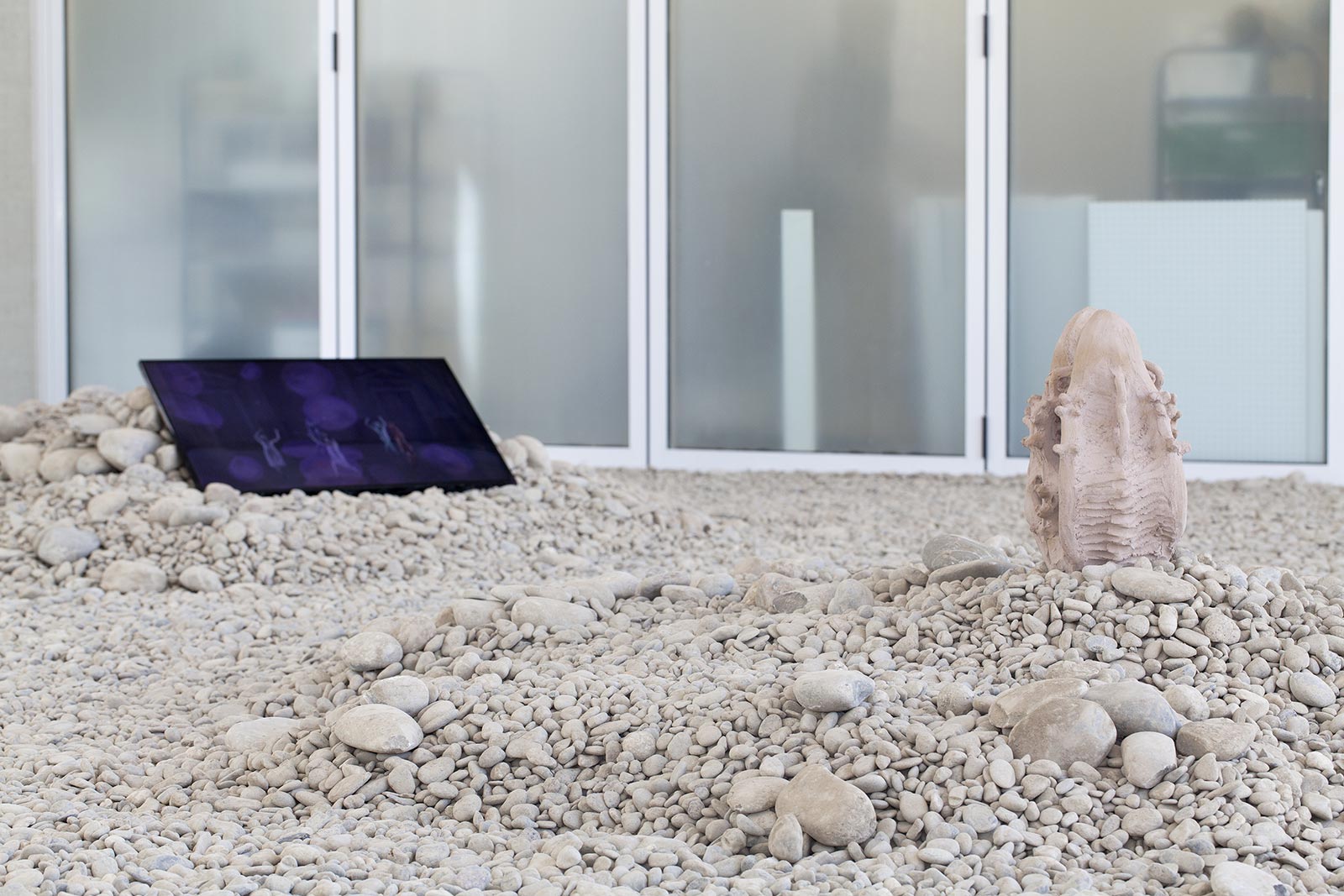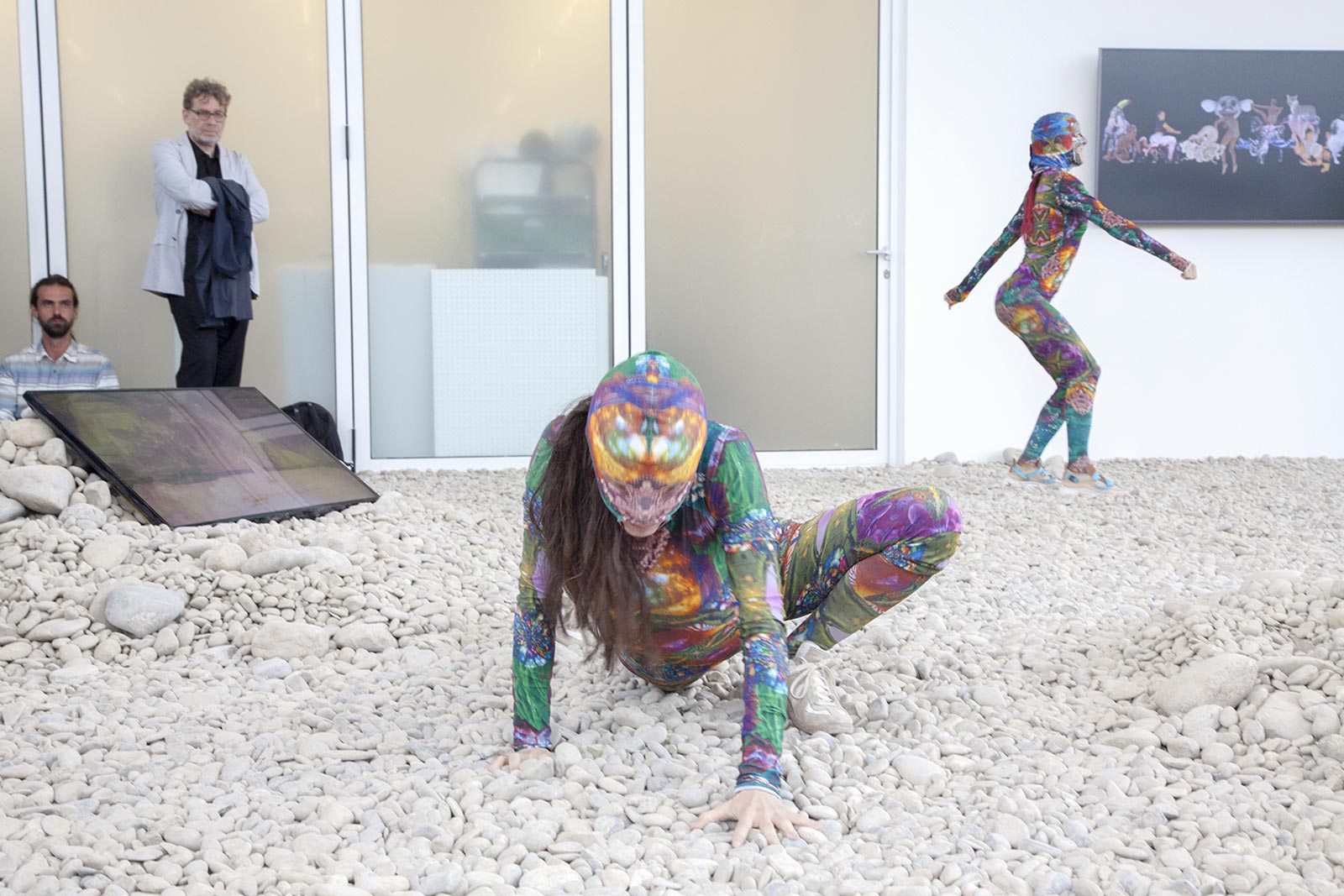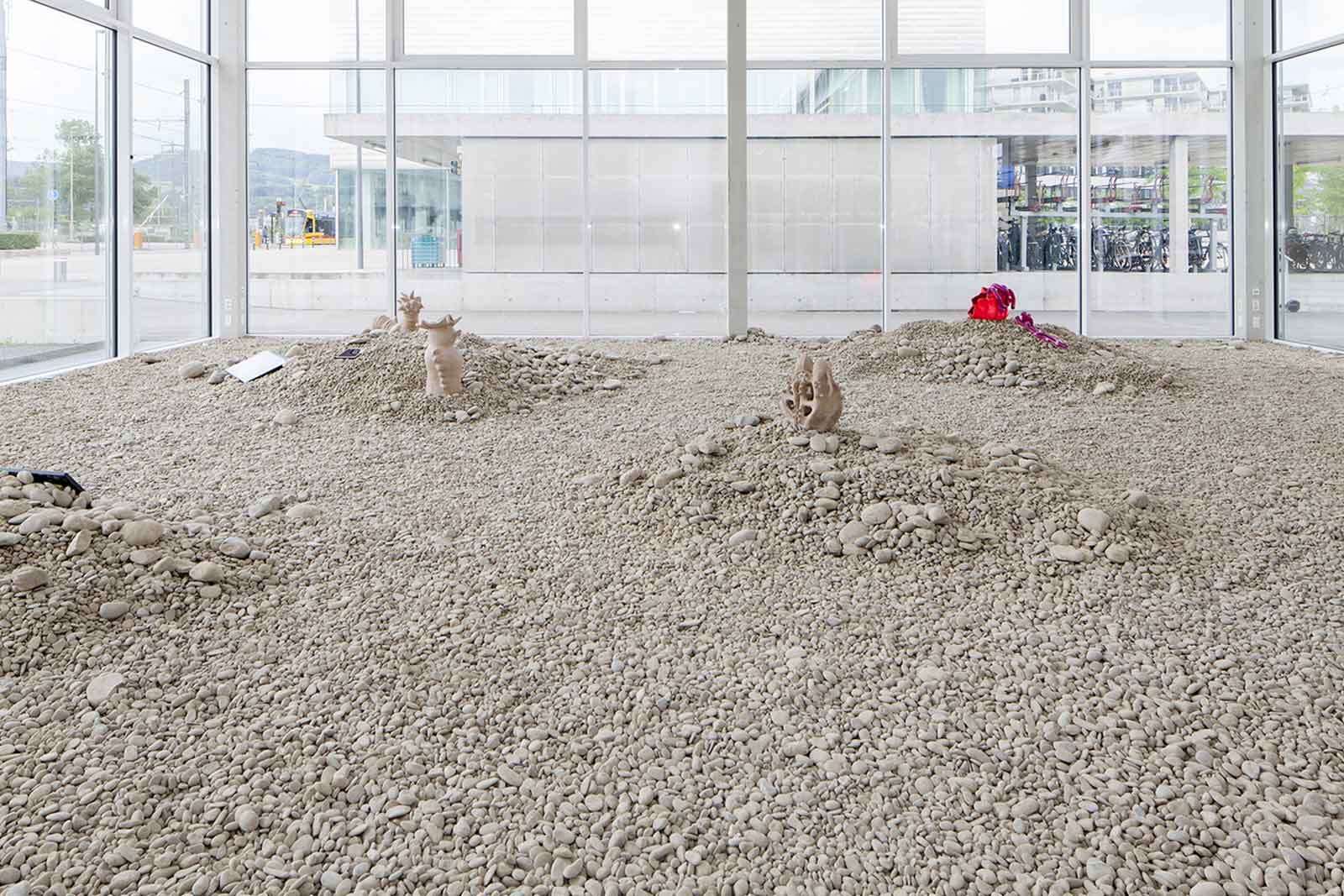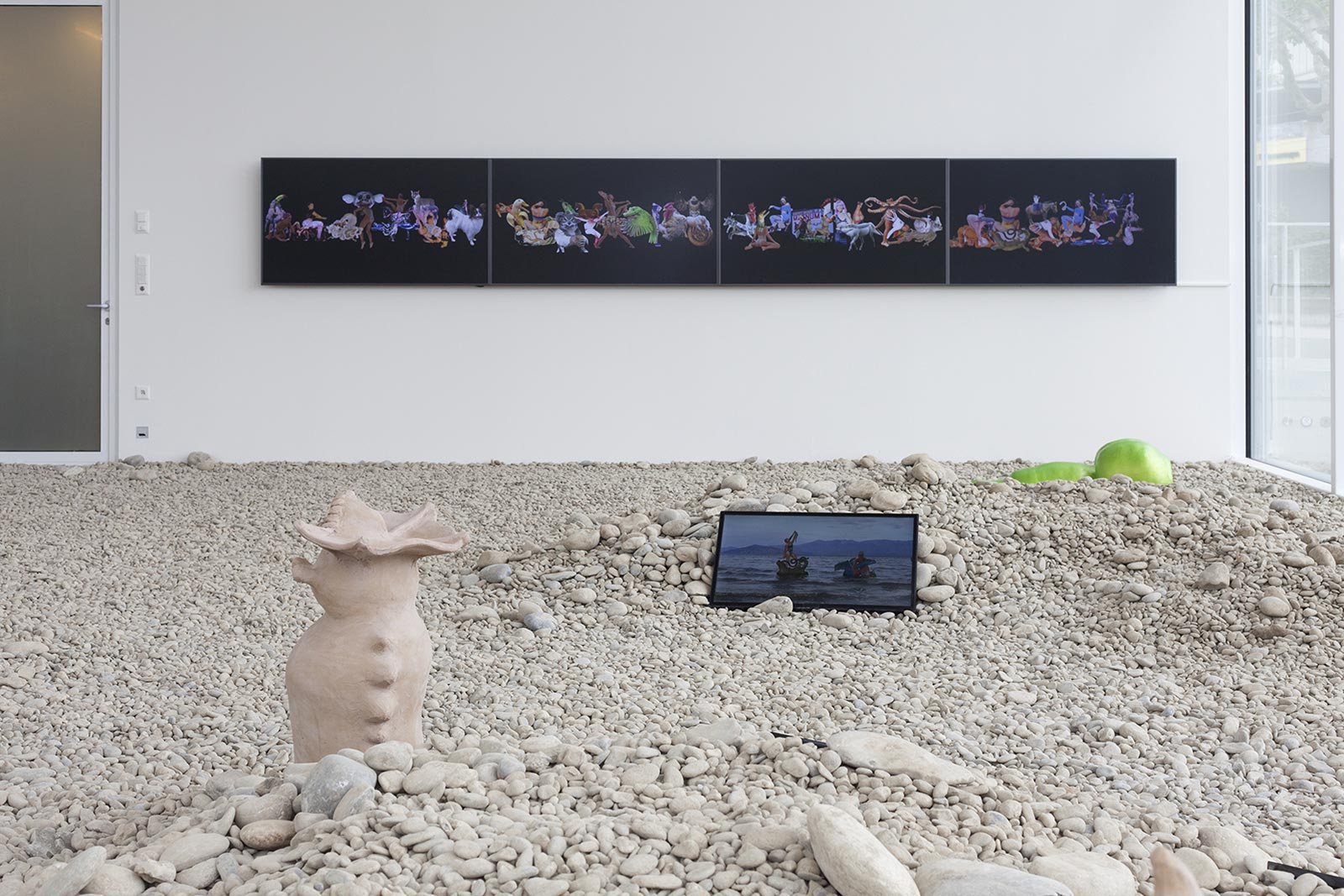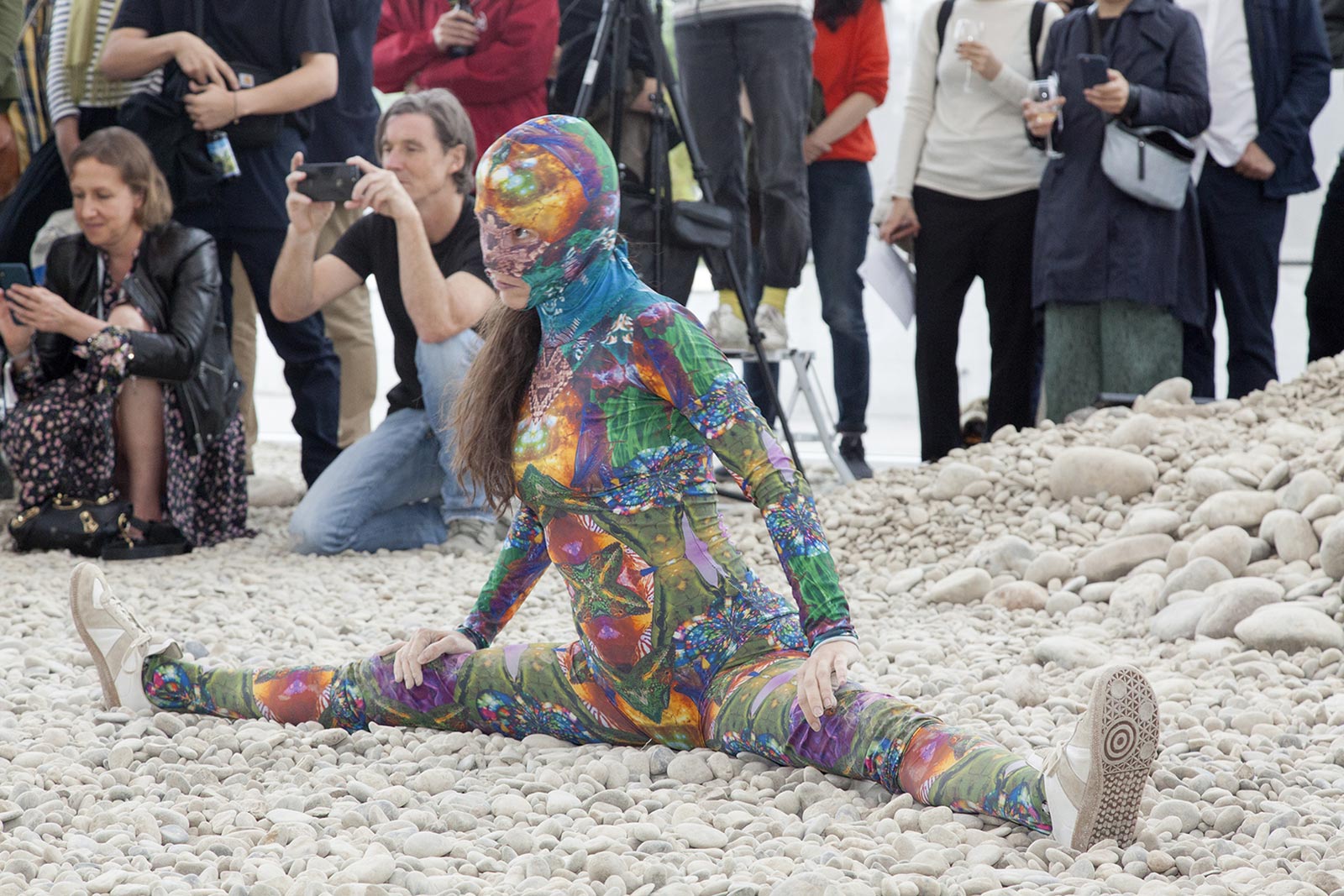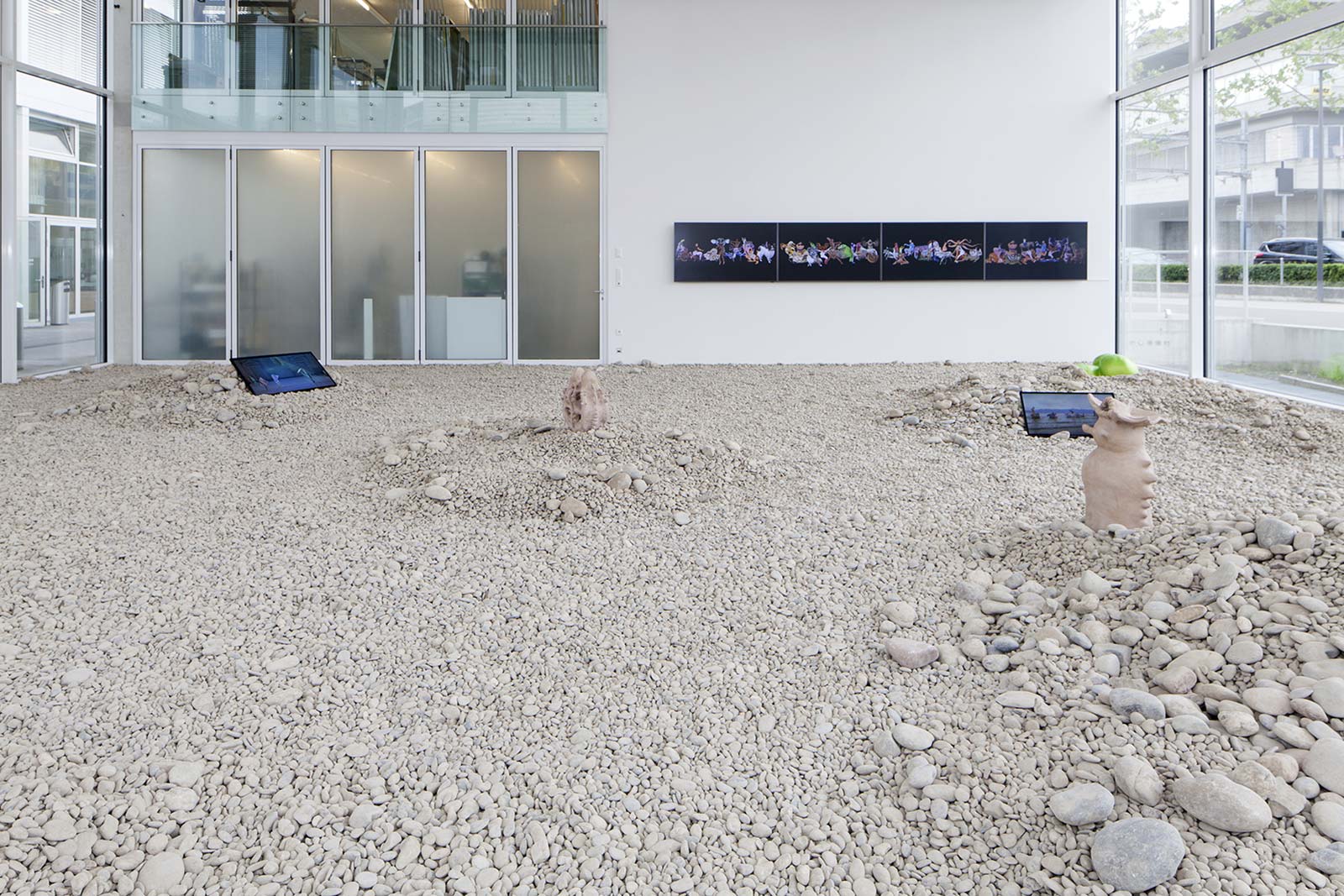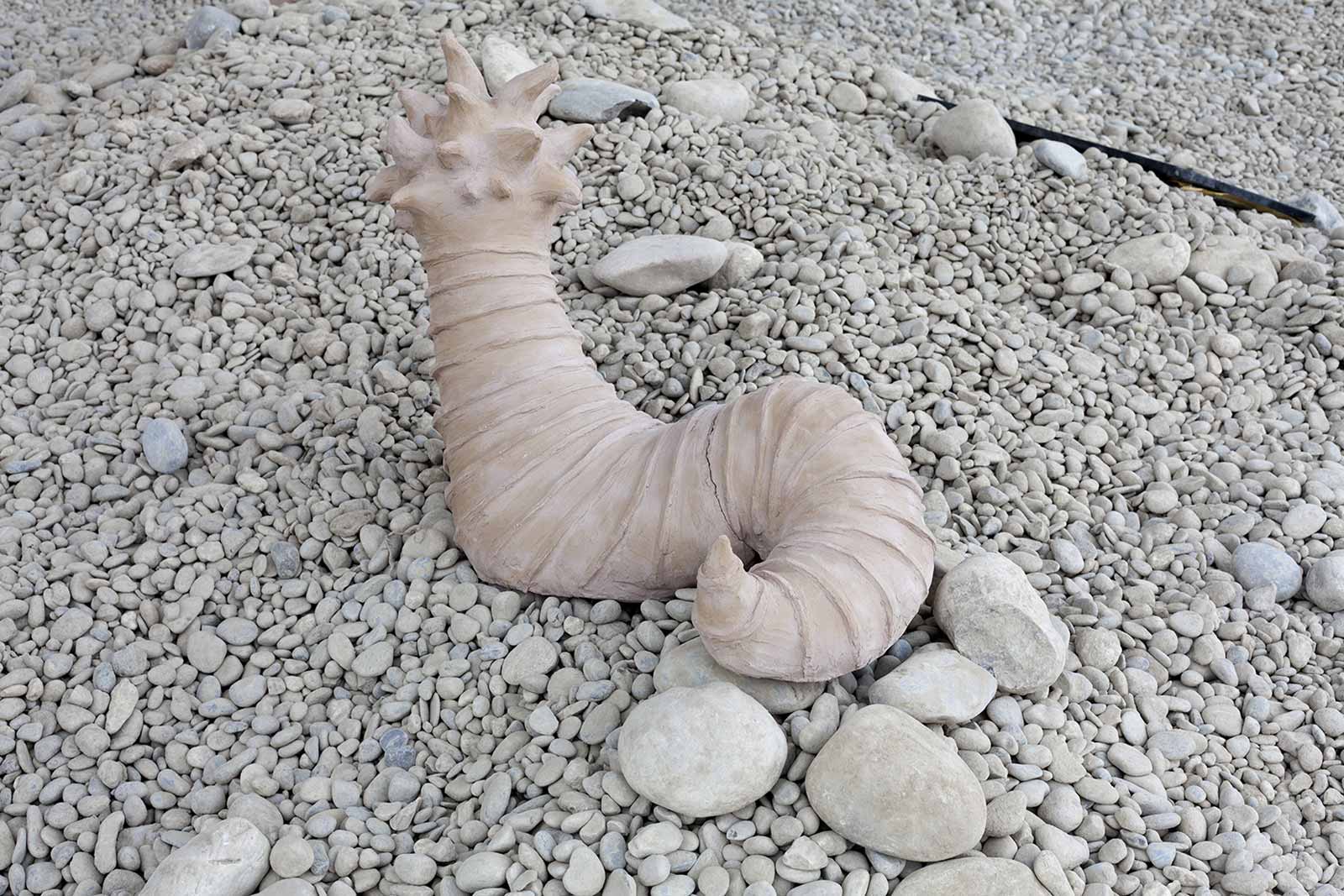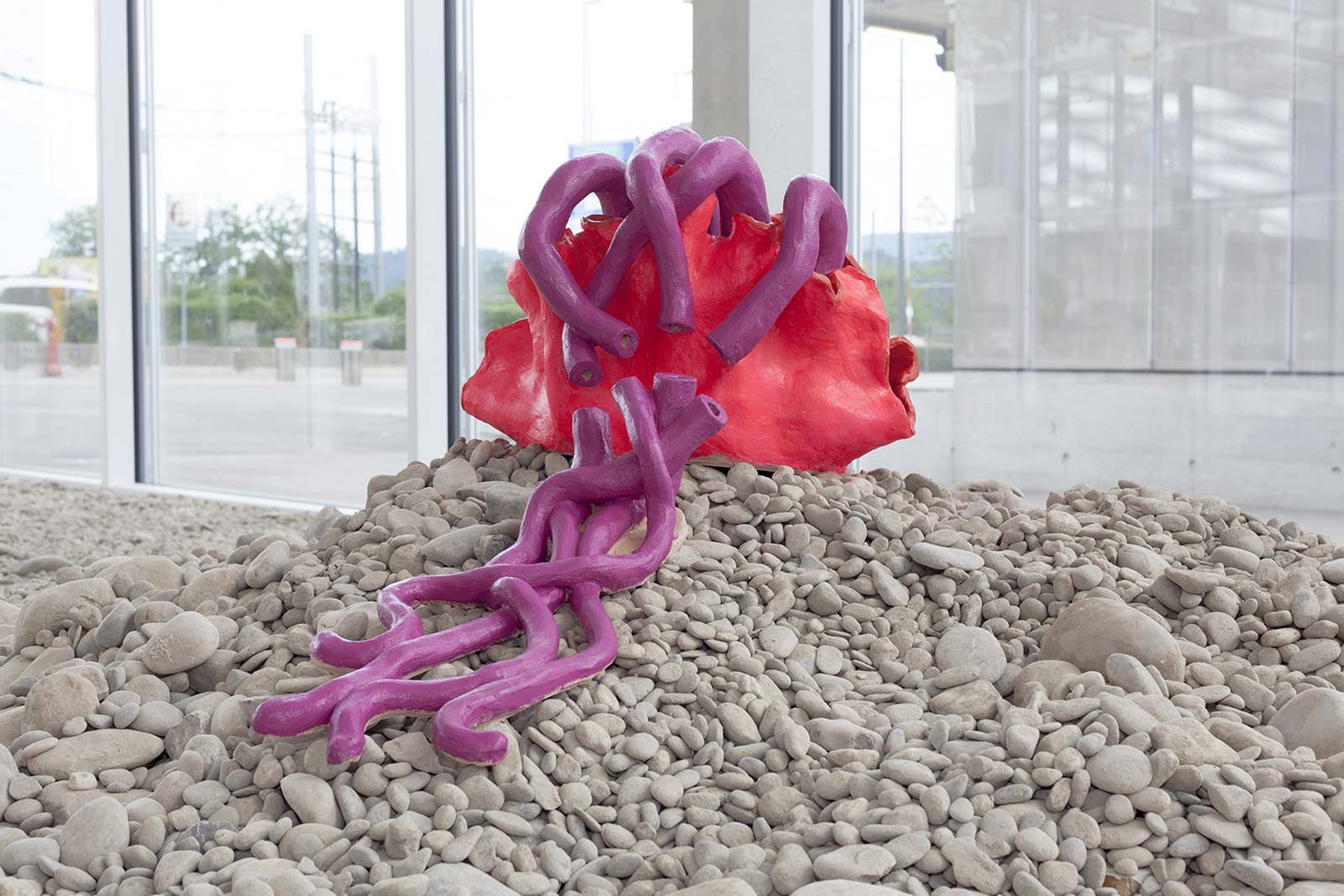The Commissions
Cecilia Bengolea
Oneness
Curated by Chus Martínez
8 – 16 June, 2019
der TANK is proud to present a new, specially commissioned project by Cecilia Bengolea and curated by Chus Martínez. Oneness articulates itself as an immersive landscape that reminds of the bottom of the sea. The installation comprises new and archive video work and will be activated on the occasion of a one-time performance by the Argentinian, Paris-based artist, dancer and choreographer.
One cannot but feel fascinated by words such as «riverbed» and «seabed»—the soft ground where the water flows. Imagine all the stones now on the floor of der TANK in their previous life at the bottom of the Rhine. In fact, there is a whole choreography in the encounter between the water and the rocks. It is not the movement of the water that erodes the rocks, but the smaller pieces of rock, sediment, and silt that constantly dance within it. These tiny bits of broken stones hit the rocks at the bottom of the river, breaking off small pieces, and the river does the rest by carrying them away. The faster the water moves, the more sediment flows over the river rocks, hastening erosion. It is easy to imagine this ballet of particles.
All the stones now forming the floor of the new performance piece by Cecilia Bengolea at der TANK miss the water, although a family of deep-sea creatures is resting on top of them. They are all invertebrate species, the type of organisms that dominate deep areas. Oh, the deep sea is an amazing world! Life in the depths is extremely slow-growing, like the time it took for the great rocks to become small stones. For both these ceramic creatures and these silent stones, time has a dimension that has nothing to do with human life. I assume that this is why Cecilia Bengolea has transformed herself into a hybrid creature capable of dancing with and for these life-forms.
Too often we talk as if climate emergency were a technical problem and could be «solved» through the adoption of certain measures. But in reality, our negative impact on nature is a cultural problem, or rather is due to the lack of a culture that sees this damage as self-inflicted pain, as domestic violence, as a negation of coexistence… This new performance and installation piece by Cecilia Bengolea is entitled Oneness or «Danse au fond de la mer» because it is in dancing and performing a different relationship with elements of nature removed from our daily experience that we are able to understand the effects of human activity, such as pollution, destructive trawl-fishing, deep sea mining, and climate change, as well as the possibility of producing different conditions to positively affect our future in oneness, in togetherness with life in a broad sense.
Oneness also marks a very fruitful four-year collaboration with the French foundation [NA!] Project. Their commitment to supporting art and artists addressing this different approach to our coexistence with nature began during dOCUMENTA (13) but has evolved over the last few years, giving rise to different initiatives such as supporting new commissions at der TANK. Mathilde Rosier, Ingela Ihrmann, Teresa Solar, and now Cecilia Bengolea have benefited from a program that not only helps the Art Institute to support artists, but also to situate these questions and praxis at the core of our curricula. We cannot conceive of nature separately from the social issues we face: gender inequality, poverty, the transformation of labor … and it is through the emergence of languages that are sensitive to them and capable of creating an artistic experience of them that we can learn to see new possibilities. Possibilities and new future scenarios that are linked with «awareness,» but—first and foremost—with the joy of a world that views its responsibility and future freedom as inextricably linked with the life of each and every one of our planet’s organisms.
Cecilia Bengolea’s performances and video installations were exhibited at Desert X (2019); the Engadin Art Talks (2019); the Venice Biennale (2019); Art Basel in Miami Beach (2018); the Ocean Space, TBA21, Venice (2018); Dhaka Art Summit (2018); Volcano Extravaganza, Fiorucci Art Trust, Stromboli (2018); Palais de Tokyo (2015 and 2018); Elevation 1049, Gstaad (2017); Dia Art Foundation (2017); Faena Arts Center, Buenos Aires (2015 and 2017); Bienal de Sao Paulo (2016); The Infinite Mix at Hayward Gallery (2016); Spiral Hall, Tokyo (2016); the Centre Pompidou (2010 and 2016); The Tanks, Tate Modern (2015); ICA, London (2015); the Biennale de Lyon (2015); The Kitchen, New York (2014); and the Gwangju Biennial (2014).
Since 2005, Bengolea has been collaborating with François Chaignaud with whom she created and presented pieces in numerous art and dance institutions around the world, among which the Ballet de l’Opéra de Lyon, the Ballet de Lorraine or Pina Bausch’s Tanztheater Wuppertal. They were awarded the Prix de la critique de Paris (2009) and the young Artist Prize at Gwangju Biennial (2014). Bengolea also frequently collaborates with dancehall artists such as Craig Black Eagle, Bombom DHQ, Damion BG and contemporary artists among which Dominique Gonzalez-Foerster and Jeremy Deller.
Cecilia Bengolea enjoys a contribution to production by [NA!] Project.
der TANK freut sich, Oneness zu präsentieren – ein neues Projekt von Cecilia Bengolea. Dieser von Chus Martínez kuratierte Auftrag artikuliert sich als eine immersive Landschaft, die an den Meeresboden erinnert. Die Installation beinhaltet neue und Archiv-Videoarbeiten und wird anlässlich einer einmaligen Performance der argentinischen, in Paris lebenden Künstlerin, Tänzerin und Choreographin aktiviert.
Man muss von Worten wie «Flussbett» und «Meeresgrund» einfach fasziniert sein – der weiche Untergrund, über den das Wasser hingleitet. Stellen Sie sich nun all die Steine, die jetzt auf dem Boden TANK liegen, während ihres früheren Lebens am Grund des Rheins vor. Tatsächlich folgt die Begegnung zwischen Wasser und Steinen einer komplexen Choreografie. Nicht die Strömung des Wassers wäscht die Steine aus, sondern die kleinen Gesteinsstücke, die Sedimente und der Schlick, die immerfort in ihm tanzen. Diese winzigen Gesteinsbrocken prallen auf die Steine am Grund des Flusses, tragen kleine Stücke ab, und den Rest besorgt der Fluss, indem er sie fortträgt. Je schneller das Wasser fliesst, desto mehr Sedimente werden über die Flusssteine gespült, die Erosion beschleunigt. Es ist leicht, sich dieses Ballet der Partikel vorzustellen.
All die Steine, die jetzt den Boden des neuen Performance-Stückes von Cecilia Bengolea beim TANK bilden, sehnen sich nach dem Wasser, obwohl eine Familie von Tiefseekreaturen auf ihnen hockt. Allesamt wirbellose Organismen, Tierarten, die die Tiefen des Ozeans beherrschen. Ach, die Tiefsee ist eine faszinierende Welt! Das Leben in der Tiefe gedeiht extrem langsam, gleich der Zeit, die es für die grossen Felsen braucht, um zu kleinen Steinchen zu werden. Sowohl die Keramikkreaturen als auch die stummen Steine haben eine Zeitlichkeit, die keine Berührungspunkte mit der menschlichen Existenz hat. Ich nehme an, dass Cecilia Bengolea sich deshalb in ein Hybridwesen verwandelt hat, das mit und für diese Lebensformen tanzt.
Allzu oft sprechen wir vom Klimawandel als einem technischen Problem, das sich durch bestimmte Massnahmen «beheben» lässt. Doch in Wirklichkeit ist die Zerstörung der Natur ein kulturelles Problem, beziehungsweise liegt es am Mangel einer Kultur, die diese Zerstörung als Selbstzerstörung einstuft, als häusliche Gewalt, als Verweigerung der Koexistenz… Diese neue Performance- und Installationsarbeit von Cecilia Bengolea trägt den Titel Oneness oder «Danse au fond de la mer», weil uns das Tanzen und Aufführen eines anderen, nicht-alltäglichen Verhältnisses mit den Elementen der Natur die Auswirkungen des menschlichen Handelns wie Umweltverschmutzung, zerstörerische Schleppnetzfischerei, Tiefseebergbau und Klimawandel vor Augen führt. Ausserdem zeigt es uns die Möglichkeit auf, andere Bedingungen zu schaffen, um unsere Zukunft in Einheit und im Miteinander mit dem Leben positiv zu gestalten.
Oneness markiert darüber hinaus eine äusserst fruchtbare vierjährige Kollaboration mit der französischen Stiftung [NA!] Project. Ihr Engagement für Kunst und Künstler*innen, die sich mit Alternativen für unsere Koexistenz mit der Natur beschäftigen, begann während der dOCUMENTA (13), wobei in den vergangenen Jahren verschiedene Initiativen aus ihr hervorgegangen sind, die unter anderem die im Rahmen von der Tank entstandenen Arbeiten fördern. Mathilde Rosier, Ingela Ihrmann, Teresa Solar und nun auch Cecilia Bengolea konnten von einem Programm profitieren, das es dem Institut Kunst ermöglicht, Künstler*innen zu fördern und diese Fragen und Praktiken im Kern unserer Curricula zu verankern. Natur lässt sich nicht getrennt von den gesellschaftlichen Fragen denken, denen wir uns stellen müssen: Geschlechterungleichheit, Armut, sich wandelnde Arbeitsbedingungen… Durch das Entstehen von Sprachen, die für diese Probleme sensibilisiert sind und sie in eine künstlerische Erfahrung verwandeln können, lernen wir neue Möglichkeiten zu erkennen. Es sind Möglichkeiten und Zukunftsszenarien, die geprägt sind von «Achtsamkeit», aber vor allem auch von der Lebensfreude einer Weltsicht, die ihre Verantwortung und zukünftige Freiheit als untrennbar verbunden mit dem Leben jedes einzelnen Organismus auf unserem Planet wahrnimmt.
Die multidisziplinäre Künstlerin Cecilia Bengolea untersucht in ihren Installationen und Performances die Geschichte des Volkstanzes und des urbanen Tanzes. Sie interessiert sich besonders für die Beziehung zur Natur, die Elementen, den animistischen Glauben und die choreographierte Figuration. Sie versteht ihre künstlerische Praxis als eine animierte Skulptur, die es ihr ermöglicht, in ihrer eigenen Arbeit sowohl Subjekt als auch Objekt zu werden.
Gezeigt wurden Cecilia Bengoleas Performances und Videoinstallationen in: Desert X (2019); den Engadin Art Talks (2019); der Venedig-Biennale (2019); der Art Basel in Miami Beach (2018); dem Ocean Space, TBA21, Venedig (2018); Dhaka Art Summit (2018); Vulkan Extravaganza, Fiorucci Art Trust, Stromboli (2018); Palais de Tokyo (2015 und 2018); Elevation 1049, Gstaad (2017); Dia Art Foundation (2017); Faena Arts Center, Buenos Aires (2015 und 2017); Bienal de Sao Paulo (2016); The Infinite Mix in der Hayward Gallery (2016); Spiral Hall, Tokyo (2016); dem Centre Pompidou (2010 und 2016); The Tanks, Tate Modern (2015); ICA, London (2015); der Biennale de Lyon (2015); The Kitchen, New York (2014); und der Biennale Gwangju (2014).
Seit 2005 arbeitet Bengolea mit François Chaignaud zusammen, mit dem sie in zahlreichen Kunst- und Tanzinstitutionen auf der ganzen Welt Werke schuf und präsentierte, darunter im Ballet de l'Opéra de Lyon, im Ballet de Lorraine oder im Tanztheater Wuppertal von Pina Bausch. Sie erhielten den Prix de la critique de Paris (2009) und den Young Artist Prize der Gwangju Biennale (2014). Bengolea arbeitet auch häufig mit Dancehall-Künstlern wie Craig Black Eagle, Bombom DHQ, Damion BG sowie zeitgenössischen Künstlern wie unter anderem Dominique Gonzalez-Foerster und Jeremy Deller zusammen.
Cecilia Bengolea geniesst einen Beitrag zur Produktion durch [NA!] Project.





